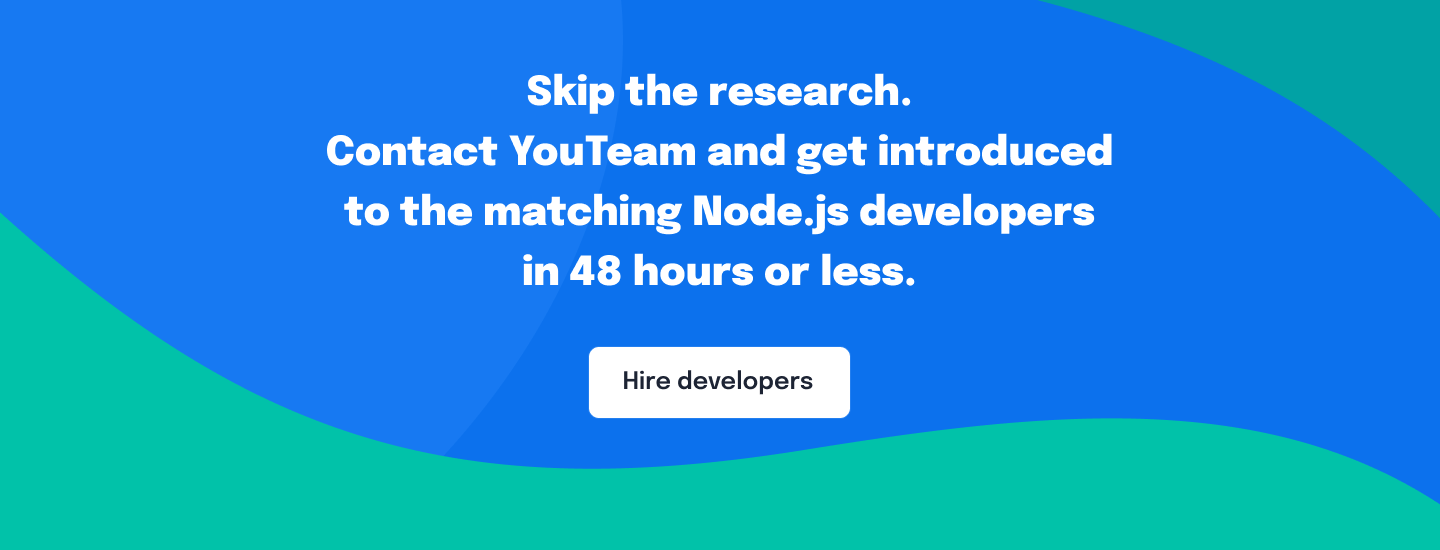Welcome to our guide crafted for those looking to hire a senior Node.js developer. Through our matching experience, we’ve identified key areas of expertise and inquiry that can help you assess candidates more effectively.
Hiring a senior developer goes beyond evaluating technical skills; it’s about finding a professional who can contribute to your project’s success and integrate well with your team.
This collection of questions, developed from insights gathered from our own experience, is designed to provide a thorough understanding of each candidate’s capabilities, problem-solving approach, and how they keep pace with the evolving Node.js ecosystem.
Table of Contents
1: Can you explain how Node.js handles non-blocking I/O operations and why this is beneficial for performance?
Expected Answer: Node.js uses non-blocking I/O operations through its event-driven architecture, allowing it to handle multiple operations in the background without waiting for any to complete. This increases performance, especially for I/O-heavy applications.
Explanation: This question tests the candidate’s understanding of Node.js’s core features and its advantages for building scalable applications.
1.1: How does the Event Loop in Node.js work, and what role does it play in the non-blocking nature of Node.js?
Expected Answer: The Event Loop allows Node.js to perform non-blocking I/O operations by offloading operations to the system kernel whenever possible. It processes completed operations as they become available, optimizing throughput and scalability.
Explanation: Knowledge of the Event Loop is crucial for understanding how Node.js achieves its non-blocking behavior.
1.2: Can you give an example of a situation where the non-blocking model of Node.js could lead to performance issues, and how you would address it?
Expected Answer: An example would be CPU-intensive tasks that block the Event Loop, causing delays in processing other asynchronous operations. Offloading these tasks to a child process or a worker thread pool can help mitigate this issue.
Explanation: This assesses the candidate’s ability to identify and solve potential performance bottlenecks in Node.js applications.
2: Discuss your experience with Node.js in building RESTful APIs. What challenges did you face, and how did you overcome them?
Expected Answer: I’ve built RESTful APIs using Node.js, focusing on creating scalable and secure endpoints. One challenge was managing asynchronous data flow, which I addressed by using async/await syntax for clearer, more maintainable code.
Explanation: This question examines the candidate’s practical experience with Node.js and their problem-solving skills in common backend tasks.
2.1: How do you ensure the security of your Node.js applications, particularly for APIs exposed to the public internet?
Expected Answer: I implement security measures like JWT for authentication, rate limiting to prevent DDoS attacks, and input validation to avoid SQL injection and XSS attacks.
Explanation: Security knowledge is vital for backend development, and this question gauges the candidate’s awareness and implementation skills.
2.2: In developing APIs, how do you handle versioning and backward compatibility in Node.js?
Expected Answer: I use URL versioning or custom headers for API versioning to maintain backward compatibility. This involves designing the API to be flexible and using deprecation warnings for outdated endpoints.
Explanation: This delves into the candidate’s approach to API design and maintenance, crucial for long-term project sustainability.
3: Node.js is known for its vast ecosystem. How do you decide on which third-party modules to include in your projects?
Expected Answer: I evaluate third-party modules based on their popularity, maintenance status, licensing, and performance. I also consider the community support and whether the module fits the project’s requirements.
Explanation: This question tests the candidate’s decision-making process in selecting tools and libraries, an essential skill for ensuring project success and maintainability.
3.1: Have you ever contributed to an open-source Node.js project? What was your experience like?
Expected Answer: [The answer will vary; the candidate may describe their contribution to an open-source project, highlighting the challenges and learnings from the experience.]
Explanation: This explores the candidate’s involvement with the Node.js community and open-source projects, indicating their passion and collaborative skills.
3.2: How do you keep up with the latest developments and best practices in the Node.js ecosystem?
Expected Answer: I follow key Node.js community leaders, attend meetups and conferences, and contribute to open-source projects. I also stay updated through blogs and newsletters.
Explanation: Staying updated with the latest trends and practices is crucial in technology, and this question assesses how the candidate ensures continuous learning and improvement.
4: What strategies do you employ for testing and ensuring the quality of your Node.js applications?
Expected Answer: I use a combination of unit testing, integration testing, and end-to-end testing frameworks like Jest, Mocha, or Cypress. I also implement continuous integration (CI) processes to automate tests and ensure code quality before merging to the main branch.
Explanation: This question investigates the candidate’s approach to maintaining high-quality code, crucial for building reliable and robust applications.
4.1: How do you approach debugging in Node.js? Can you share a tool or technique that you find particularly effective?
Expected Answer: I use the built-in Node.js debugger and Chrome DevTools for debugging. For complex issues, I might use advanced logging with tools like Winston or Bunyan, which help track down problems by providing detailed contextual logs.
Explanation: Debugging skills are essential for any developer, and this question seeks to understand the candidate’s problem-solving approach and familiarity with Node.js debugging tools.
4.2: Can you explain the importance of environment variables in Node.js applications and how you manage them across different environments?
Expected Answer: Environment variables are crucial for configuring applications across different environments without changing code. I use dotenv for local development and ensure that production secrets are stored securely, for example, in a cloud service’s managed secret storage.
Explanation: This addresses the candidate’s knowledge of application configuration management, a key aspect of deploying and maintaining scalable applications.
5: Node.js supports both traditional callbacks and Promises for asynchronous operations. How do you decide which to use in your projects?
Expected Answer: I prefer Promises and async/await syntax for their readability and error handling capabilities. However, I might use callbacks for simpler tasks or when dealing with legacy code that relies on them.
Explanation: This question delves into the candidate’s ability to work with asynchronous JavaScript, highlighting their understanding of different patterns and when to apply them.
5.1: What are some of the pitfalls of asynchronous code in Node.js, and how do you avoid or mitigate them?
Expected Answer: Common pitfalls include callback hell, leading to hard-to-read code, and unhandled promise rejections. I use async/await to write cleaner code and ensure to catch errors in promise chains or using try/catch blocks with async functions.
Explanation: The ability to identify and handle asynchronous code issues is crucial in Node.js development. This question assesses the candidate’s problem-solving skills and best practices.
5.2: How do you optimize the performance of Node.js applications, especially in handling a large number of concurrent connections?
Expected Answer: I use techniques like clustering to take advantage of multi-core systems, caching responses to reduce database load, and streamlining I/O operations. Additionally, I monitor performance using profiling tools to identify and address bottlenecks.
Explanation: Performance optimization is key for scalable Node.js applications. This question aims to uncover the candidate’s strategies for ensuring applications can handle high loads efficiently.
6: Describe how you use environment variables in Node.js for managing application configurations across different environments.
Expected Answer: I use the “dotenv” package for local development to load environment variables from a “.env” file. For production, I ensure environment variables are set securely in the hosting platform’s configuration, such as in Heroku, AWS, or Docker containers, to manage sensitive configurations like database URLs and API keys without hardcoding them in the source code.
Explanation: This assesses the candidate’s understanding of secure and scalable app configuration practices, crucial for maintaining security and flexibility across environments.
6.1: Can you explain how to secure Node.js applications against common security threats, like SQL Injection or Cross-Site Scripting (XSS)?
Expected Answer: To protect against SQL Injection, I use parameterized queries or ORM libraries that automatically sanitize input. For preventing XSS, I ensure that user input is properly escaped before rendering and use content security policies to mitigate risks.
Explanation: Understanding common web vulnerabilities and how to defend against them is essential for a secure application development process.
6.2: What strategies do you employ for monitoring and improving the performance of a Node.js application in production?
Expected Answer: I use monitoring tools like New Relic or Prometheus to track application performance and identify bottlenecks. Implementing logging and tracing helps in understanding the application flow and pinpointing issues quickly. To improve performance, I focus on optimizing database queries, reducing unnecessary computations, and leveraging caching.
Explanation: This question gauges the candidate’s proactive approach to performance monitoring and optimization in live environments.
7: How do you handle file uploads in a Node.js application?
Expected Answer: I use middleware like “multer” for handling multipart/form-data file uploads in Node.js applications. It allows for easy configuration of storage options, file size limits, and file type filtering to ensure security and efficiency.
Explanation: Handling file uploads securely and efficiently is a common requirement for web applications, and this question tests the candidate’s experience with implementing such features in Node.js.
7.1: In Node.js, how do you manage large file operations, such as reading or writing large files, without impacting server performance?
Expected Answer: For large file operations, I use streams in Node.js to read or write files in chunks, preventing memory overload and improving efficiency by processing files piece by piece.
Explanation: This showcases the candidate’s knowledge of Node.js streams, an important feature for handling I/O-bound tasks efficiently.
7.2: What are some of the best practices for error handling in Node.js, especially in asynchronous code?
Expected Answer: In asynchronous code, I make sure to catch errors at every promise chain or async function using “.catch()” blocks or “try/catch”. I also use central error handling middleware in Express applications to manage errors consistently.
Explanation: Proper error handling is crucial for building robust applications. This question assesses the candidate’s strategies for managing errors, particularly in asynchronous operations.
8: How do you ensure that your Node.js applications are scalable and can handle growth in traffic?
Expected Answer: To ensure scalability, I use load balancing with a reverse proxy like Nginx or HAProxy, employ clustering to take advantage of multi-core systems, and design the application for horizontal scaling with stateless architecture wherever possible. Additionally, optimizing code and database queries, as well as implementing caching strategies, are key for handling increased loads.
Explanation: Scalability is a critical aspect of web application development. This question evaluates the candidate’s understanding of and approach to building scalable Node.js applications.
8.1: Can you describe your approach to API design in Node.js? How do you ensure that your APIs are maintainable and user-friendly?
Expected Answer: I follow RESTful principles for API design, ensuring endpoints are logically organized and use HTTP methods semantically. I also use versioning to manage changes without breaking existing clients and document the API using specifications like OpenAPI for clarity and ease of use.
Explanation: A well-designed API is essential for the success of web services. This question looks at the candidate’s approach to API architecture and documentation.
8.2: How do you manage dependencies in a Node.js project to prevent compatibility issues or security vulnerabilities?
Expected Answer: I regularly audit dependencies using tools like “npm audit” or “snyk” to identify and address security vulnerabilities. To manage compatibility, I specify precise version ranges in “package.json” and use “package-lock.json” to lock down the versions of installed packages.
Explanation: Dependency management is a key aspect of maintaining a secure and stable codebase. This question explores the candidate’s practices for keeping dependencies up-to-date and secure.
9: What has been your experience with using WebSocket in Node.js for real-time applications?
Expected Answer: I have used WebSocket in Node.js for developing real-time features such as chat applications or live notifications. By establishing a persistent connection between the client and server, WebSocket allows for bidirectional communication, enhancing the interactivity of web applications.
Explanation: This question assesses the candidate’s experience with building real-time features, an increasingly common requirement in modern web development.
9.1: Can you discuss a specific project where you optimized a Node.js application for high performance? What strategies did you employ?
Expected Answer: In a recent project, I optimized performance by profiling the application to identify bottlenecks, implemented caching with Redis to reduce database load, and optimized critical paths in the codebase. I also used compression and optimized static asset delivery to improve response times.
Explanation: Real-world examples of performance optimization provide insights into the candidate’s problem-solving abilities and knowledge of optimization techniques.
9.2: How do you approach internationalization (i18n) in Node.js applications?
Expected Answer: For internationalization, I use libraries like “i18next” to manage translations and ensure that the application supports multiple languages efficiently. This involves organizing translation files, dynamically loading them based on user preferences, and integrating language selection into the UI.
Explanation: Supporting multiple languages is important for global applications. This question looks at the candidate’s experience with implementing i18n in Node.js projects.
10: How do you stay updated with the latest Node.js features and community best practices?
Expected Answer: I follow key figures in the Node.js community on social media, participate in forums and discussion groups, attend meetups and conferences, and contribute to open-source projects. Additionally, I regularly read blogs and technical articles related to Node.js.
Explanation: Continuous learning is vital in the fast-evolving tech field. This question explores how the candidate engages with the community and keeps their skills sharp.
10.1: Have you ever faced a significant challenge while upgrading Node.js versions in a project? How did you handle it?
Expected Answer: Yes, during an upgrade, I encountered breaking changes that affected several dependencies. I addressed this by thoroughly testing the application in a staging environment, updating or replacing incompatible dependencies, and gradually rolling out the update to minimize impact.
Explanation: Upgrading major software versions can introduce challenges. This question reveals the candidate’s ability to manage transitions and solve compatibility issues.
10.2: Discuss a time when you had to significantly refactor a Node.js application. What was the reason, and how did you approach the task?
Expected Answer: I refactored an application to improve its architecture and incorporate modern practices like async/await. The process involved breaking down the application into smaller, more manageable modules, improving error handling and logging, and introducing unit and integration tests to ensure stability.
Explanation: Refactoring is a common task aimed at improving code quality. This question assesses the candidate’s approach to maintaining and improving existing codebases.
Final Thoughts
As you conclude your search to hire a senior Node.js developer, remember that the right candidate should not only demonstrate strong technical expertise but also show a deep understanding of project and team dynamics.
The questions outlined in this guide, drawn from our platform’s research and industry best practices, are intended to help you uncover these qualities. It is also good to test the candidate’s soft skills, how freely they can communicate their thoughts and ideas, their problem-solving skills. To do that, you can check out our soft skills assessment questions that you can customize based on your preferences.
By focusing on problem-solving abilities, adaptability to new technologies, and a collaborative mindset, you’ll be better positioned to find a developer who not only meets your technical requirements but also contributes positively to your team culture.
Keep these considerations in mind to ensure a successful addition to your team, fostering growth and innovation in your projects.






